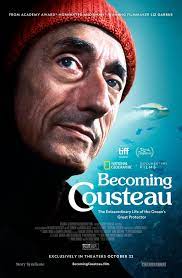
BECOMING COUSTEAU
US, 2021, 93 minutes, Colour.
Directed by Liz Garbus.
Before his death in 1997 at the age of 80, French diver, Jacques-Yves Cousteau, was an international figure, honoured by national leaders around the world. This is a documentary tracing his career as a diver, his contribution science and innovation, especially the aqualung (leading to scuba developments), his expeditions, his films and television series, his growing realisation about the destruction of the oceans, his becoming a universal campaigner and crusader.
This film was made for National Geographic and has that audience strongly in mind, an audience who appreciates films about the wonders of nature, especially in underwater life, but also audiences who are committed to the preservation of world heritage to falling s. It is not a biography of Cousteau although there are some personal elements of his life throughout the film. For those who want a feature film version of his life, the French film, The Odyssey (2016), stars Lambert Wilson as Cousteau, Audrey Tautou as his wife, Simone, and Pierre Ninny any as his son, Philippe. (Although some aspects of Cousteau’s personal life, especially his second family and his second wife are alluded to in The Odyssey but made quite explicit in Becoming Cousteau.) The Dir of this documentary, Liz Garber’s, has a very strong and long list of documentary achievements, especially documentaries about Marilyn Monroe, Gloria Vanderbilt and Nina Simone.
There are many scenes with Philippe Cousteau who worked with his father on the boat, for the television programs, scenes of bonding with his father – and the sad accident of his death.
Cousteau is a genial screen presence. There are many interviews, television appearances, addresses to international organisations. The filmmakers have the advantage of the Cousteau archives, a great range of photographs starting with his childhood, a great range of home video material, of black-and-white footage, colour material, and excerpts from his films and documentaries. They give quite a round picture of Cousteau and his achievements.
The film pays tribute to his early life, an accident and having to swim to overcome it, his exhilaration in the discoveries of diving, his work in the Navy – and his forever afterwards being referred to as Captain Cousteau, his development of the aqualung during the 1940s (the film not mentioning his work in the Resistance), the collaboration with friends enabling divers to spend longer times underwater and go deeper. He wrote a book, The Silent World, 1954, filmed and Oscar-winning in 1956. This began a long career of film and television making, awards, popularity in the US, and beyond.
However, Cousteau went through something of a conversion experience. Early film shows some brutality in landing sharks and battering them. Cousteau and his team, with his re-conditioned boat, Calypso, were invited to help in the underwater search for oil. Cousteau says in the 1970s that he watched The Silent World again and repudiated much that was in it. He then became an international crusader for the preservation of the oceans, showing sequences of coral reef devastation (an alert to Australians about the Great Barrier Reef), contamination, pollution, refuse and garbage in the sea.
He was the leading speaker at the United Nations Conference in Rio de Janeiro in 1992, gaining pledges of countries around the world (including glimpses of a very affable Fidel Castro), and the development of his Cousteau Foundation.
Cousteau’s long life was completely in the 20th century – but, his work and inspiration are more relevant than ever in the 21st-century.